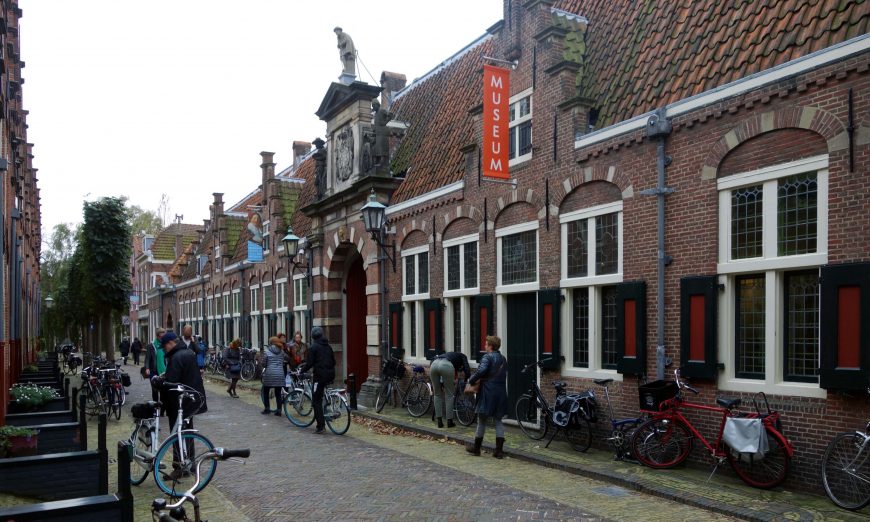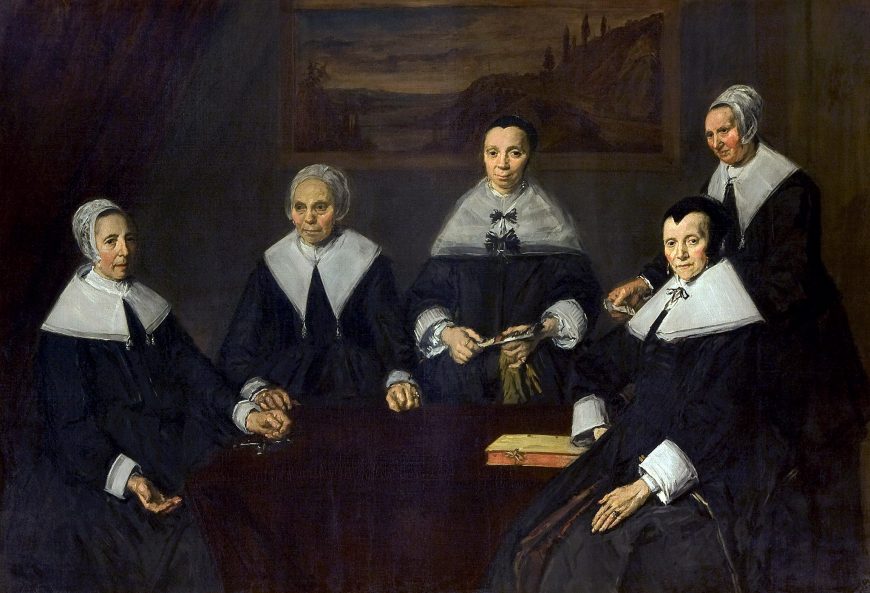
Frans Hals, The Woman Regents, c. 1664, oil on canvas, 170.5 x 249.5 cm (Frans Hals Museum, Haarlem)
“[He] excels almost everyone with the superb and uncommon manner of painting which is uniquely his …. [His portraits] are colored in such a way that they seem to live and breathe.”—Theodor Schrevelius (1572-1649)
Haarlem was a prominent city in the seventeenth-century Netherlands and a leading center for the Golden Age of Dutch art. Still life, landscape, and genre painting were wildly popular, but there was also a surge in portrait commissions due to the newfound wealth of the many merchants who flocked to this area. As one of the foremost painters of this period, Frans Hals received many portrait commissions—especially from the Haarlem elite who sought to preserve their likeness and demonstrate their status. Hals’s painterly approach to art set him apart from his contemporaries; there is a looseness in his brushwork and liveliness in his sitters that is unique.
For the open market (in other words, not commissioned works), Hals created portraits of the common members of society including children, drunkards, and musicians—most are depicted smiling or laughing (far removed from the more reserved representations of the elite).
Depicting these marginal figures allowed Hals the freedom to experiment with facial expressions while still maintaining each figure’s individuality (above and below left). Hals received many commissions from wealthy individuals, but also made a name for himself with his group portraits. Some of these prestigious commissions were for guilds (associations of craftsmen or merchants) or civic guards, while others, such as The Women Regents (top of page) were for charitable groups.
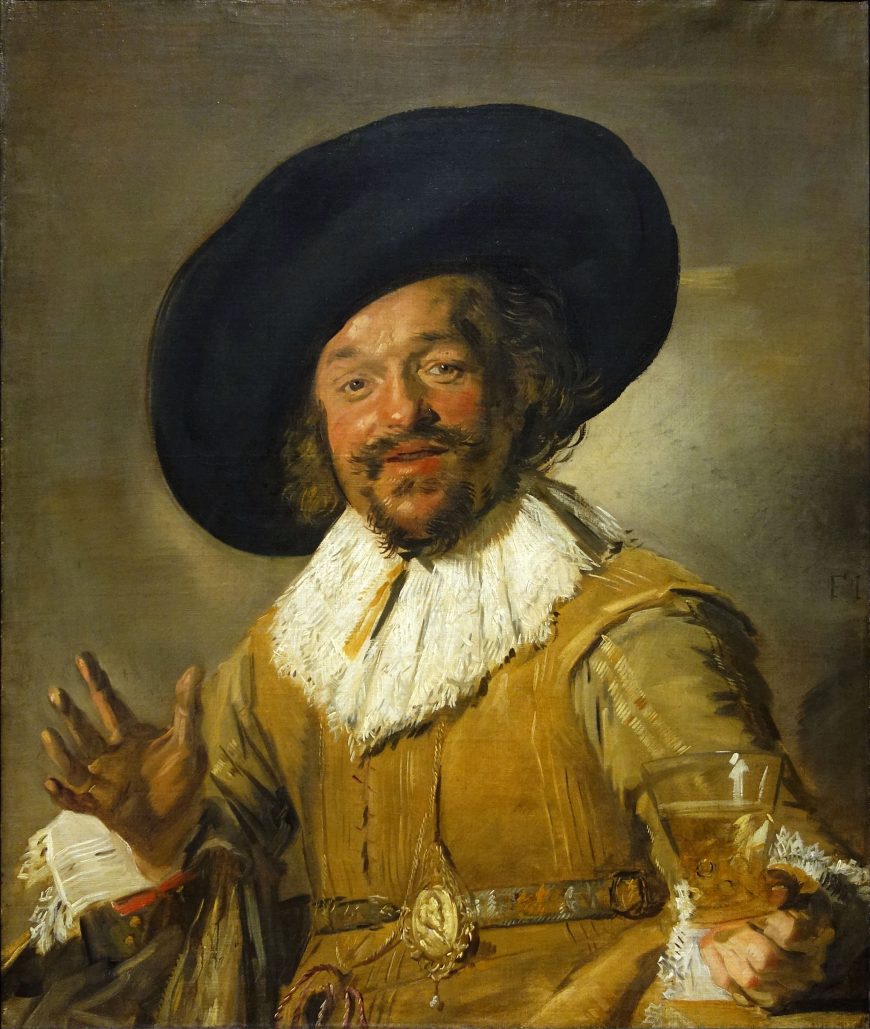
Frans Hals, A Militiaman Holding a Berkemeyer (The Merry Drinker), c. 1628-30, oil of canvas, 81× 66.5 cm (Rijksmuseum, Amsterdam)
Group portraits such as these were typically displayed in a public space where the sitters’ status and good deeds could be recognized. Founded in 1609, the Old Men’s Almshouse (Oude Mannenhuis) was governed by a board of regents and provided shelter and care for elderly single men. This portrait, along with its companion painting depicting the male regents (below), was likely made in 1664, when Hals was 81 or 82 years old. In The Women Regents five women are clustered around a table in the immediate foreground. The painting is somber—dominated by blacks and grays that are punctuated by the white collars of the women’s clothes. Depicted in traditional Calvinist clothing, the women are not only representing their caretaking profession, but also the dominant religion of the Dutch Republic.
The women are quiet and austere. Perhaps they are weary from their responsibility in caring for the elderly poor, or perhaps they are simply serious about their task of governing the almshouse. Regardless, there is a dignity in the figures and a clear intention to individualize them, both through their likenesses and different poses.
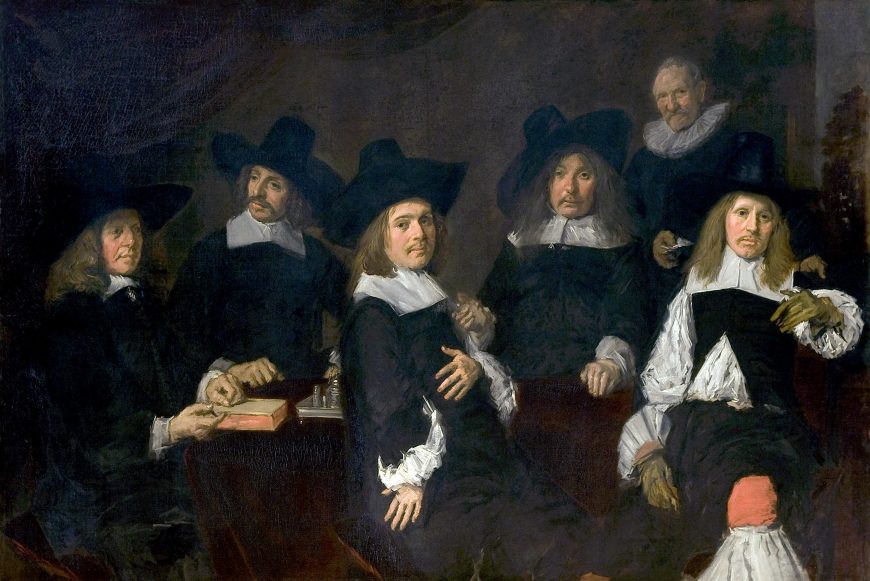
Frans Hals, Regents of the Old Men’s Alms House, c. 1664, oil on canvas, 172.3 x 256 cm (Frans Hals Museum, Haarlem)
The background is simple; a landscape painting hangs on the wall behind the women and a large swath of drapery sweeps across the upper left corner. Although it is a stark contrast from Hals’s jovial militia banquet group portraits (below), there is still a sense of a captured moment in time. The women are posed and arranged so that the viewer has a full view of each of them. A few of them are in mid-pose—one even appears to have just entered the scene from the right. Only three stare out at the viewer. Textured brushwork combined with the repetitive triangular shapes of the women’s bodies and their collars provide a sense of movement. While this painting is a stark contrast from his earlier jovial portraits of individuals, The Women Regents still embodies Hals’ penchant for expressive and textured brushwork. This technique is especially evident in the cuffs of the central standing figure where the brushstrokes simultaneously retain their painterly quality and give the illusion of texture. The cuffs are rendered with a series of quick lines encircling the woman’s wrists, yet from afar the paint strokes blend together, alluding to the qualities of a stiff, pleated fabric. Overall, the scene is still; however, through his virtuosity in brushwork, Hals has bestowed it with a sense of life, as if this painting represents these women in a specific moment in time.
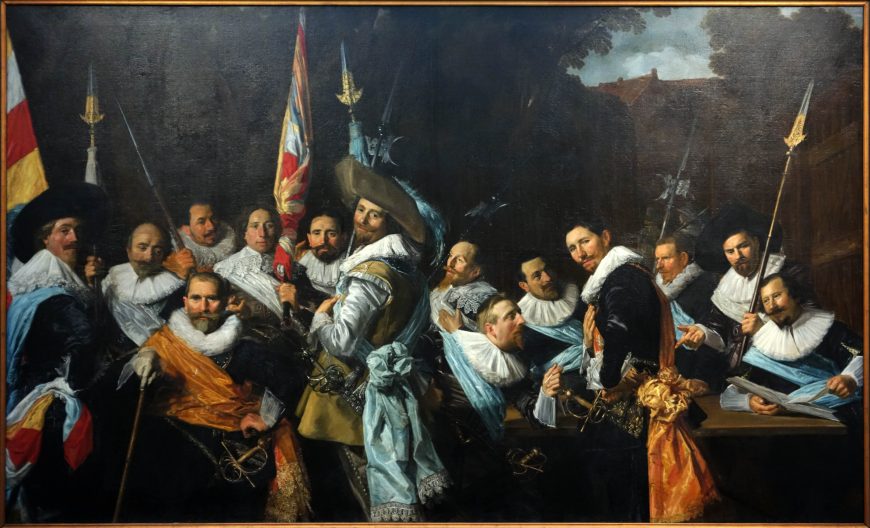
Frans Hals, Meeting of the Officers and Sergeants of the Civic Cavalry Guard, 1633, oil on canvas, 207 x 337 cm (Frans Hals Museum, Haarlem)
There is scant information about Hals’s early life and upbringing. He was born in Antwerp, but moved to Haarlem as a child where he spent the entirety of this life. The first significant recorded moment of his artistic career is when he joined the painters’ guild of St. Luke in Haarlem in 1610, however there is little reliable information regarding his artistic training. Unfortunately he suffered financial obstacles throughout his life and was forced to sell many of his paintings and personal goods in order to repay debts and care for his many children. Although Hals died in relative poverty, his influence was significant. Judith Leyster employed Hal’s loose handling of paint and sense of the moment in her own portraits, and centuries later the Impressionists admired his brushwork.
Today visitors can see The Women Regents and many other Hals paintings at the Frans Hals Museum in Haarlem (above), which just so happens to be in the building of the former Old Men’s Almshouse.
Additional Resources:
Hals on The Metropolitan Museum of Art’s Heilbrunn Timeline of Art History
Christopher Atkins, The Signature Style of Frans Hals: Painting, Subjectivity, and the Market in Early Modernity (Amsterdam: Amsterdam University Press, 2011).
Calvinism and Religious Toleration in the Dutch Golden Age. Edited by R. Po-Chia Hsia and Henk F. K. van Nierop. (New York: Cambridge University Press. 2002).
Walter Liedtke, Frans Hals: Style and Substance (New York: Metropolitan Museum of Art, 2011).


